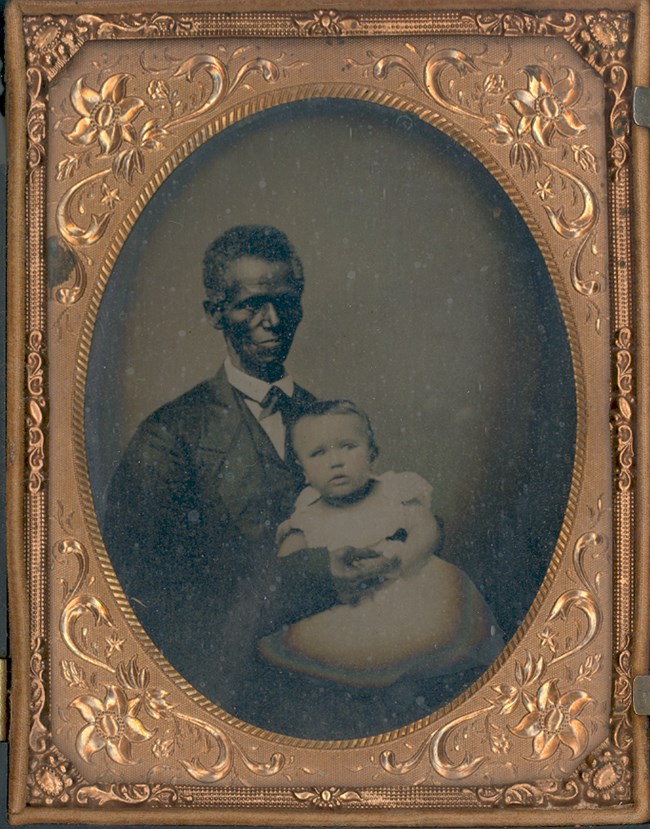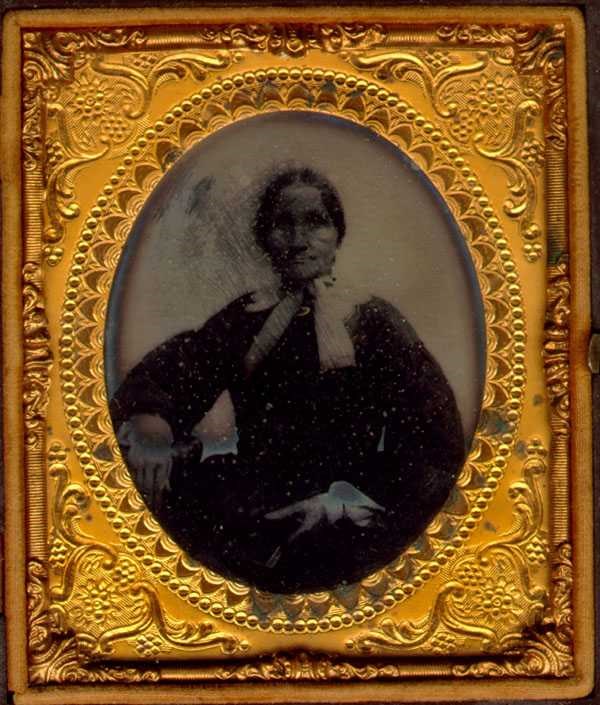Maria Teresa's Babies Early Enrichment Center Arlington Va

NPS
Maria Syphax was the daughter of an enslaved maid named Arianna Carter, and George Washington Parke Custis who was built-in in 1803 at an undetermined location. This may have been at Mount Vernon where Carter may have been enslaved, Arlington Plantation, or somewhere else. Maria may not have been Custis's just child from an enslaved adult female, but she seemed to receive special, paternal attending from him.
In 1821, he allowed her to marry Charles Syphax, an enslaved house servant, in the parlor of Arlington House, x years before Custis's white girl, Mary, would wednesday Lt. Robert E. Lee in the same room. Charles Syphax was the son of a free blackness itinerant Alexandria street preacher and an enslaved woman from Mount Vernon. He was enslaved at the Mount Vernon manor and was transferred to Arlington Firm when Martha Washington died, ane of fifty-seven enslaved people who came to Arlington from Mountain Vernon with George Washington Parke Custis in 1802. He was near ix years former. The enslaved people owned by the Custis family unit ended upward moving not simply to Arlington Business firm, but also Tudor Identify and Woodlawn. The separation at Mount Vernon was a centre-wrenching time; enslaved people who were emancipated in George Washington's will were separated sometimes from family unit and friends who were enslaved to Martha Washington'due south manor – the majority of the people enslaved at Mount Vernon. At Arlington House, Charles Syphax oversaw the dining room and was the unofficial leader of the Arlington enslaved customs.
Custis permitting Maria and Charles to ally was not unusual. Many slaveholders immune it though it was not legally recognized. Marriage between enslaved individuals was not explicitly prohibited by constabulary, but they did not receive any legal recognition considering the individuals were considered belongings. The slaveholder still retained ultimate control of the individuals, and their human relationship, and could, at any moment, separate them by selling one or both away. They also benefited from the 'increase', or the children that were born to enslaved individuals. In some cases, these weddings included the vow, "until decease or distance exercise you function."
Afterward Maria and Charles were married, they were forced to go on working in the house, Charles in the dining room, and Maria equally maid to her half-sister Mary Custis. 4 years and ii children later, Custis sold Maria and the children, but non Charles, to Edward Stabler, a Quaker apothecary in Alexandria. Beingness a Quaker, Stabler was against slavery and often purchased enslaved individuals to free them, which is what is idea he did with Maria and her children.
This is where the history, once more, becomes muddled. It is assumed Stabler freed Maria and her ii children, just information technology does not appear on record until 1845, twenty years subsequently. Why not? What happened during that time? Had the entry been lost? Had information technology been covered up for some reason? Had it been a verbal "gentleman'south understanding"? Until direct proof is uncovered, we can just theorize.

NPS
Before long later on gaining her liberty, Maria caused seventeen acres on the southwest portion of Custis' Arlington holding to live on as a gratis person. She and Charles had eight more children, all born free since a child'southward status of servitude was dependent on the mother. Charles Syphax would remain enslaved until December 29, 1862, when the terms of Custis' 1857 will stated all of the Arlington enslaved people were to exist freed.
During the Civil War, a Freedman's Village was established on the grounds of Arlington. Over a thousand recently emancipated people settled on the property. Maria and her family unit were involved in the activities of the Freedman'southward Village, education skills such as sewing, and acting every bit advocates on behalf of individuals to petition the authorities for assistance. Freedman's Village was closed and it residents were required to evacuate before 1900.
In 1863, tax laws were changed in office to raise coin to back up the expanding Civil War that was underway. Local jurisdictions had the ability to plant to arts and crafts the local tax law and mandated that taxes be paid in person by the legal owner of the holding being taxed. Mary Anne Lee attempted to pay the tax, but was rebuffed because she did not announced in person. The Custis property was confiscated. Along with that action the 17-acre Syphax belongings also was confiscated because they had no proof or ownership. Maria's eldest son, William, used relationships he had built working equally a messenger in the Interior Department. He wrote an statement defending the rights of his mother to ownership of the property that was given to her by her father even though there was no definitive documentation to bear witness the gift occurred. William Syphax used his connections within the authorities to get a nib introduced in Congress, the "Nib for the Relief of Maria Syphax." On May 18, 1866, Sen. Ira Harris (R-NY) explained to the Commission on Individual Lands Claims that information technology was for a woman who had in one case been enslaved by George Washington Parke Custis. The bill was voted on, passed, and signed by President Andrew Johnson. The property was returned to Maria Syphax. Sen. Harris after told The Congressional World that the committee's decision had been "simply." Syphax property ownership was reaffirmed by Congress in 1884 during a period when the Lee descendants sued the Federal government for inappropriately confiscating the 1,100-acre property that was inherited by Mary Lee from her father prior to the state of war.
Maria Syphax died in 1886 leaving the 17 acres to exist divided amid the surviving children. Families grew and with the exception of Ennis Syphax dispersed into the wider Washington, DC, surface area and beyond. In 1944, the 17 acres was condemned and for the second time the remaining Syphaxes were expelled from the property they were given by George Washington Parke Custis and returned by Congress.
We don't know many specifics about Maria Syphax. Scattered data that has been uncovered over the years, through archived manumission records, tax assessments, oral history reports, newspaper accounts, and Congressional hearings, has given u.s.a. just a glimpse of who she was. In dissimilarity, we know a not bad bargain about of the lives of the Custis and Lee families: what they ate on any given day, what they wore, or visited with. Mayhap it's a niggling surprising to our 21st-century eyes that someone who was as intimately connected to them as Maria Syphax was would exist so little-known. Or perhaps non, considering the relationship.
Maria Syphax's story is one of perseverance and dedication. It is forever intertwined in the history of the Arlington plantation. In addition, the legacy the Syphax family continues to be felt today. Maria Syphax's son William was appointed the first chairman of the DC Board of Trustees of Colored Public Schools and established Dunbar High School, the first black loftier school in the Commune of Columbia; and his brother John Syphax served as justice of the peace of the Arlington Magisterial Board and afterward was elected delegate to the Virginia General Assembly. Over the years, dozens of Syphax descendants have served honorably in the military, many attended and taught at Howard University and other prestigious universities, been elected to congress and advocated for social justice reform.
Source: https://www.nps.gov/arho/learn/historyculture/syphax.htm
0 Response to "Maria Teresa's Babies Early Enrichment Center Arlington Va"
Postar um comentário